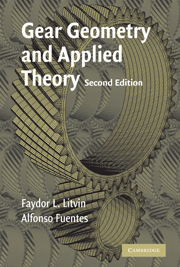Book contents
- Frontmatter
- Contents
- Foreword by Graziano Curti
- Preface
- Acknowledgments
- 1 Coordinate Transformation
- 2 Relative Velocity
- 3 Centrodes, Axodes, and Operating Pitch Surfaces
- 4 Planar Curves
- 5 Surfaces
- 6 Conjugated Surfaces and Curves
- 7 Curvatures of Surfaces and Curves
- 8 Mating Surfaces: Curvature Relations, Contact Ellipse
- 9 Computerized Simulation of Meshing and Contact
- 10 Spur Involute Gears
- 11 Internal Involute Gears
- 12 Noncircular Gears
- 13 Cycloidal Gearing
- 14 Involute Helical Gears with Parallel Axes
- 15 Modified Involute Gears
- 16 Involute Helical Gears with Crossed Axes
- 17 New Version of Novikov–Wildhaber Helical Gears
- 18 Face-Gear Drives
- 19 Worm-Gear Drives with Cylindrical Worms
- 20 Double-Enveloping Worm-Gear Drives
- 21 Spiral Bevel Gears
- 22 Hypoid Gear Drives
- 23 Planetary Gear Trains
- 24 Generation of Helicoids
- 25 Design of Flyblades
- 26 Generation of Surfaces by CNC Machines
- 27 Overwire (Ball) Measurement
- 28 Minimization of Deviations of Gear Real Tooth Surfaces
- References
- Index
11 - Internal Involute Gears
Published online by Cambridge University Press: 04 September 2009
- Frontmatter
- Contents
- Foreword by Graziano Curti
- Preface
- Acknowledgments
- 1 Coordinate Transformation
- 2 Relative Velocity
- 3 Centrodes, Axodes, and Operating Pitch Surfaces
- 4 Planar Curves
- 5 Surfaces
- 6 Conjugated Surfaces and Curves
- 7 Curvatures of Surfaces and Curves
- 8 Mating Surfaces: Curvature Relations, Contact Ellipse
- 9 Computerized Simulation of Meshing and Contact
- 10 Spur Involute Gears
- 11 Internal Involute Gears
- 12 Noncircular Gears
- 13 Cycloidal Gearing
- 14 Involute Helical Gears with Parallel Axes
- 15 Modified Involute Gears
- 16 Involute Helical Gears with Crossed Axes
- 17 New Version of Novikov–Wildhaber Helical Gears
- 18 Face-Gear Drives
- 19 Worm-Gear Drives with Cylindrical Worms
- 20 Double-Enveloping Worm-Gear Drives
- 21 Spiral Bevel Gears
- 22 Hypoid Gear Drives
- 23 Planetary Gear Trains
- 24 Generation of Helicoids
- 25 Design of Flyblades
- 26 Generation of Surfaces by CNC Machines
- 27 Overwire (Ball) Measurement
- 28 Minimization of Deviations of Gear Real Tooth Surfaces
- References
- Index
Summary
INTRODUCTION
A gear drive composed of external and internal gears is considered. Application of such a train enables us to reduce the loss of power caused by sliding of tooth profiles. This effect is the result of the reduction of the relative angular velocity ω(12) = ω(1) − ω(2), where |ω(12)| = |ω(1) − ω(2)|. (Recall that the gears perform rotation in the same direction). However, a high reduction of |ω(12)| requires a small difference ΔN of the numbers of teeth of the pinion and the internal gear. The possible interference of tooth profiles by the gear assembly, and the undercutting of the internal gear in the process of generation, should be investigated before designation of the desired value of ΔN. Another advantage of application of an internal gear train is the possibility of reducing the dimensions of the train. Trains with internal gears are applied in planetary transmissions, in transmissions of cranes, in excavators, and so on.
The problems of undercutting of internal involute spur gears in the process of generation and interference by their assembly with pinions have been studied by several researchers. The phenomenon of undercutting of internal involute gears was first discussed by Schreier [1961]. Polder [1991] has extended this research and contributed the idea of the envelope to a family of extended hypocycloids.
- Type
- Chapter
- Information
- Gear Geometry and Applied Theory , pp. 304 - 317Publisher: Cambridge University PressPrint publication year: 2004
- 2
- Cited by

